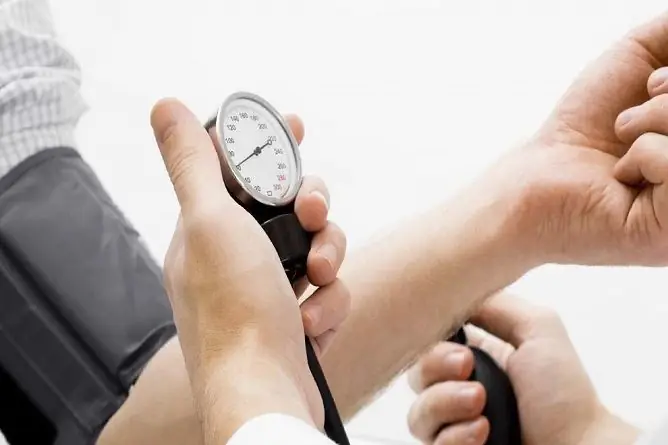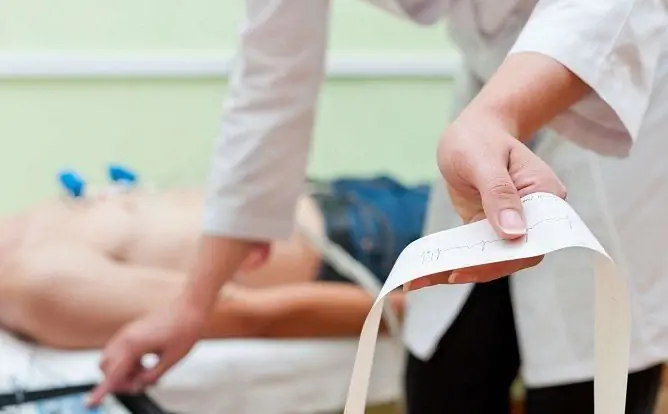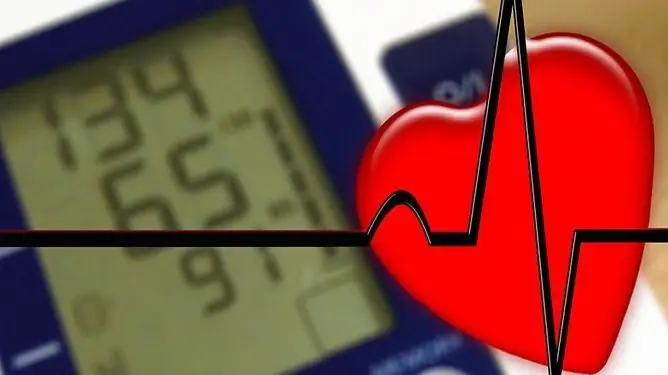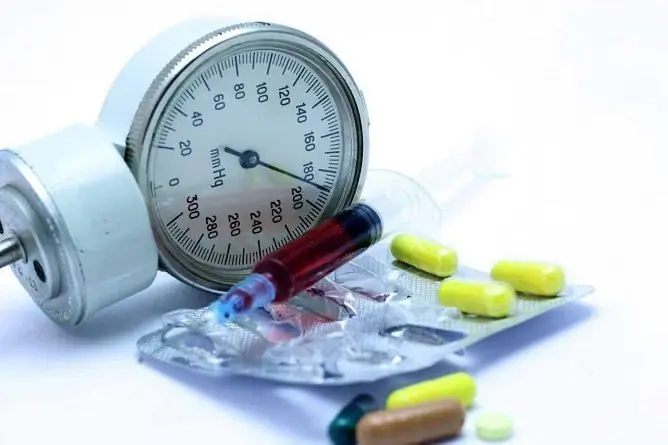- Author Rachel Wainwright [email protected].
- Public 2023-12-15 07:39.
- Last modified 2025-11-02 20:14.
Low bottom pressure: causes, symptoms, treatment
The content of the article:
- Blood pressure and its decrease
- Causes of low bottom pressure
- The main signs of lowered diastolic pressure
- Low bottom pressure - what to do?
- Treatment
- Prevention
- Video
Low lower pressure, which is also called vascular or renal, can be caused by problems with both blood vessels and kidneys, and with a number of other diseases. In most cases, its decrease occurs together with the upper one (hypotension) and is not a sign of serious pathology. However, if the lower pressure decreases in isolation, and especially if this condition lasts for a long time, it is necessary to undergo an examination, find out the cause and eliminate it, since this phenomenon causes blood stagnation in the large and pulmonary circulation.

If low diastolic pressure persists for a long time and causes discomfort, you need to see a doctor
Let's talk about why diastolic blood pressure drops and what to do about it.
Blood pressure and its decrease
Blood pressure (BP) is the pressure that blood puts on the walls of blood vessels as it moves. Distinguish between systolic (upper) and diastolic (lower) pressure. With a decrease in diastolic pressure, the systolic pressure also usually decreases, but in some cases there is a low lower pressure with an increased or normal upper pressure.
Blood pressure of 120 to 80 mm Hg is considered normal in an adult. Art. (the second number means diastolic pressure), fluctuations in the indicator up or down by 10-15 units are permissible. The difference between the upper and lower pressure in a person (pulse pressure) should normally be approximately 40 mm Hg. Art. A deviation of this indicator by 10 units in one direction or another is acceptable.
The value of blood pressure is influenced by the total volume of circulating blood, the patency of blood vessels, the state of the heart and a number of other factors. If the patient's blood pressure is consistently low, he is diagnosed with arterial hypotension (hypotension), even if only one of the indicators is reduced.
There are several types of arterial hypotension. With orthostatic hypotension, a decrease in blood pressure occurs with sudden movements, which is accompanied by a loss of orientation in space, severe weakness, and fainting. Most often, this form of hypotension is observed in elderly patients. Vegeto-vascular hypotension usually occurs during adolescence and is associated with dysfunction of the cardiovascular system. Postprandial hypotension develops after a meal, and is more common in older people or those with diabetes.
Reduced blood pressure is much less likely to cause the development of myocardial infarction and stroke in comparison with the increased one; only a sharp and significant drop in it is a serious danger.
Causes of low bottom pressure
What does a low diastolic blood pressure mean? The reasons for lowering the lower pressure are varied. It can change under the influence of psycho-emotional factors, with the use of certain foods and drinks (especially alcohol), the use of a number of drugs (for example, with prolonged use of antidepressants). Decreased lower pressure can be caused by high ambient temperatures, being in a stuffy room, or using marijuana. However, in such cases, the value of the indicator usually quickly returns to normal limits.
Pathological decrease in diastolic blood pressure is observed in kidney diseases, allergic processes, toxic shock, dehydration of the body, astheno-neurotic syndrome, hypotonic somatoform autonomic dysfunction of the nervous system, insufficient production of thyroid hormones, a number of infectious diseases (tuberculosis, pneumonia, etc.), blood loss (trauma, heavy menstruation), a lack of vitamins in the body, B, C, E. A decrease in diastolic and pulse pressure is observed in patients with chronic heart failure.
Diastolic blood pressure below normal occurs in women during pregnancy, especially in the early stages. While it is normal for a child to carry a baby, a slight decrease in blood pressure is normal, but it increases the risk of fainting. In addition, it is not uncommon for pregnant women to experience dehydration, which leads to an even greater decrease in blood pressure.
An increase in systolic blood pressure with a simultaneous decrease in diastolic blood pressure occurs in kidney disease, atherosclerotic lesions of the blood vessels, in hyperthyroidism, and overweight. This condition can be observed in patients with hypertension if not properly treated.
Low diastolic blood pressure with normal systolic pressure can be observed in some malignant neoplasms.
In elderly patients with grade 2 and 3 arterial hypertension, a decrease in diastolic pressure may indicate myocardial infarction, renal failure, stroke.
The risk factors for lowering the lower pressure include a change in the climatic zone, meteosensitivity.
The main signs of lowered diastolic pressure
A decrease in blood pressure is accompanied by discomfort. When a person's blood pressure drops, there is increasing weakness, lethargy, drowsiness, apathy, and decreased efficiency. There may be a dull or throbbing headache (often in the occipital and / or temporal region), dizziness, fainting, nervousness, very severe irritability.
With a reduced diastolic pressure, patients may experience blurred vision, the appearance of spots before the eyes, chest discomfort, increased heart rate, coldness of the upper and lower extremities, orthostatic collapse. These symptoms can develop both with an isolated decrease in diastolic blood pressure and with general hypotension.
With increased upper and decreased lower pressure, facial hyperemia, headache, shortness of breath, tachycardia, tremor of the upper extremities are observed.
At what value of the lower pressure fainting is possible depends on the patient's normal blood pressure, as well as on a number of his physiological characteristics. So, in some people, fainting is possible with a diastolic pressure of 64 mm Hg. Art., and in other cases it occurs at 56-58 mm Hg. Art.
With a diastolic blood pressure of 47 mm Hg. Art. and less urgent medical attention is required, since this value is approaching critical.
Low bottom pressure - what to do?
First of all, you should adjust your lifestyle. It is necessary to normalize the regime of work and rest, a full night's sleep, increased physical activity, as well as normalization of nutrition. You need regular meals at regular intervals, balanced in composition. It is recommended to include more fruits, vegetables, dairy products in the diet. Patients may be advised to practice yoga, breathing exercises.
For slightly lower diastolic blood pressure at home, you can use herbal tonics such as ginseng and lemongrass. However, it should be borne in mind that drugs based on these medicinal plants are contraindicated in case of high systolic pressure, epilepsy, a tendency to bleeding, acute infectious processes in the body, sleep disorders.
Tea with currant leaves is effective: mix a teaspoon of black tea with the same amount of crushed black currant leaves, pour a glass of boiling water and leave for 15 minutes. Tea with currants is drunk a glass a day after meals. You can also brew currant leaves without adding black tea.

Currant leaf tea has a tonic effect
With a reduced diastolic pressure, a chicory root remedy can be used. To prepare it, 2 tablespoons of crushed plant roots need to be poured with 500 ml of warm water, boiled over low heat for 30 minutes. After that, filter the broth and take 1/3 cup 3 times a day. The course of treatment should not exceed 4 weeks.
If home remedies do not help, if the diastolic blood pressure is lowered significantly and remains at this level for a long time, you should see a doctor.
Treatment
To find out the cause of the lowered lower blood pressure, an examination is carried out, which includes a general and biochemical blood test, a general urine test, determining the level of thyroid hormones in the blood, electrocardiography, echocardiography and other studies, if necessary.
Treatment is mainly directed at the underlying disease. So, with hypothyroidism, drugs can be prescribed to help normalize the functioning of the thyroid gland. In astheno-neurotic syndrome, neurometabolic stimulants are used, etc.
To normalize blood pressure, tonics can be prescribed, especially in the case when the cause of hypotension cannot be identified. Toning drugs help to normalize blood pressure, eliminate drowsiness, weakness, lethargy and apathy. In some cases, they are prescribed together with drugs that strengthen the blood vessels.
It is not recommended to self-medicate, as independent attempts to increase the lower pressure with drugs will most likely lead to an increase in upper pressure. Such treatment of low lower pressure in elderly patients can cause the development of a hypertensive crisis.
Prevention
In order to prevent pathological conditions characterized by low lower pressure, a healthy lifestyle and proper nutrition are recommended. The diet should include meat, potatoes, legumes, nuts, dark chocolate. You need to sleep at least 8 hours a day, you should spend more time in the fresh air. Moderate physical activity, rejection of bad habits, avoidance of industrial hazards, adherence to an adequate regime of work and rest are recommended. It is useful to take a contrast shower, which helps to strengthen the walls of blood vessels, increase immunity.
Video
We offer for viewing a video on the topic of the article.

Anna Aksenova Medical journalist About the author
Education: 2004-2007 "First Kiev Medical College" specialty "Laboratory Diagnostics".
Found a mistake in the text? Select it and press Ctrl + Enter.






